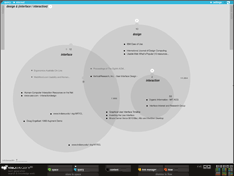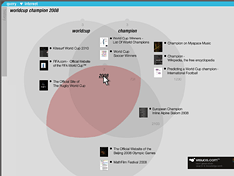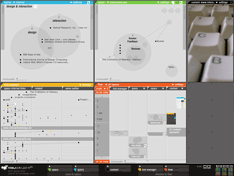the feeling of 'having it under control'visuospatial interfaces™ |
||||||
the visuospatial interfaces™ paradigm stands for interaction structures that offer a spatially consistent organization |
||||||
the core modules of vısuos™ |
||||||
 |
 |
vısuos·search™ offers a powerful, easy to use basis for querying any class of private or public information space. each search term is represented by a circle. Boolean expressions are represented by combinations of circles and are simply operated by direct manipulation. vısuos·space™ offers a unified visualization for multiple dialects of hierarchical and linear structured public and private hypermedia resources that in classical solutions are represented in independent, inconsistent forms. |
||||
 |
 |
vısuos·linkmanager™ is a time-based module. the link section offers a context space and is a basis for navigating elements linked to the one in focus. the trail section tracks the user's selections and visually connects them. vısuos·flow™ is a linear structured, time-based space representing the past, present and future of all processes. module states and the users' actions are logged and visually represented and can be recalled at any point of time. future actions can be scheduled. |
||||
visual query - direct refinement |
||||||
 |
 |
vısuos·search™ allows the user to see the distribution of results.
when there's not the desired result, he can understand which term does not perform as wanted and refine via direct manipulation within the model (output = input). in this example the user wants to find a worldcup champion. he accidentally uses "2008" as the third search term. |
||||
integration - workflows across modules |
||||||
 |
 |
the system architecture allows to flexibly combine the modules needed. So it easily adapts to higher workflows involving multiple classes of activity. tight integration of the modules' conceptual models allows seamless interactions across all of them. The result is a highly scalable system. |
||||
configuration & details |
||||||
 |
 |
multiple perspectives, information breadths, and mechanisms of accessing information are offered. the linear mode side module is an alternative text based approach to sets & elements, landmarks, internal links, and cross instance trails (workflow connections to other vısuos modules). the settings menu allows the advanced user to configure the modules of vısuos to his specific needs. |
||||
|
|||||||||||||||||||